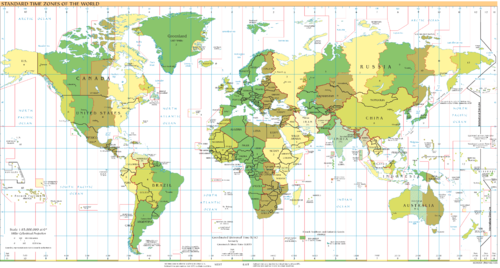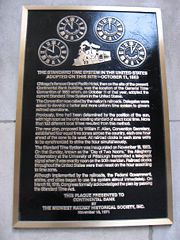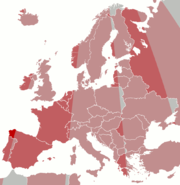Time zone
2008/9 Schools Wikipedia Selection. Related subjects: Geography; Physics
A time zone is a region of the Earth that has adopted the same standard time, usually referred to as the local time. Most adjacent time zones are exactly one hour apart, and by convention compute their local time as an offset from UTC (see also Greenwich Mean Time).
Standard time zones can be defined by geometrically subdividing the Earth's spheroid into 24 lunes (wedge-shaped sections), bordered by meridians each 15° of longitude apart. The local time in neighbouring zones would differ by one hour. However, political and geographical practicalities can result in irregularly-shaped zones that follow political boundaries or that change their time seasonally (as with daylight saving time), as well as being subject to occasional redefinition as political conditions change.
Before the adoption of time zones, people used local solar time. Originally this was apparent or true solar time, as with a sundial, and later it became mean solar time. Mean solar time has days of equal length, such that the difference from apparent solar time, called the equation of time averages to zero over a year.
This became increasingly awkward as railways and telecommunications improved, because clocks differed between places by an amount corresponding to the difference in their geographical longitude, which was usually not a convenient number. This problem could be solved by synchronizing the clocks in all localities, but then in many places the local time would differ markedly from the solar time to which people are accustomed. Time zones are thus a compromise, relaxing the complex geographic dependence while still allowing local time to approximate the mean solar time. There has been a general trend to push the boundaries of time zones further west of their designated meridians in order to create a permanent daylight saving time effect. The increase in worldwide communication has further increased the need for interacting parties to communicate mutually comprehensible time references to one another.
Standard time zones
Earlier, time zones based their time on Greenwich Mean Time (GMT, also called UT1), the mean solar time at longitude 0° (the Prime Meridian). But as a mean solar time, GMT is defined by the rotation of the Earth, which is not constant in rate. So, the rate of atomic clocks was annually changed or steered to closely match GMT. But on January 1, 1972 it became fixed, using predefined leap seconds instead of rate changes. This new time system is Coordinated Universal Time (UTC). Leap seconds are inserted to keep UTC within 0.9 seconds of UT1. In this way, local times continue to correspond approximately to mean solar time, while the effects of variations in Earth's rotation rate are confined to simple step changes that can be easily subtracted if a uniform time scale ( International Atomic Time or TAI) is desired. With the implementation of UTC, nations began to use it in the definition of their time zones instead of GMT. As of 2005, most but not all nations had altered the definition of local time in this way (though many media outlets fail to make a distinction between GMT and UTC). Further change to the basis of time zones may occur if proposals to abandon leap seconds succeed.
Due to daylight saving time, UTC is local time at the Royal Observatory, Greenwich only between 01:00 UTC on the last Sunday in October and 01:00 UTC on the last Sunday in March. For the rest of the year, local time there is UTC+1, known in the United Kingdom as British Summer Time (BST). Similar circumstances apply in many places.
The definition for time zones can be written in short form as UTC±n (or GMT±n), where n is the offset in hours. These examples give the local time at various locations at 12:00 UTC when daylight saving time (or summer time, etc.) is not in effect:
- Los Angeles, California, United States: UTC−8; 04:00
- New York City, United States: UTC−5; 07:00
- Saint John, New Brunswick, Canada: UTC−4; 08:00
- London, United Kingdom: UTC; 12:00
- Paris, France : UTC+1; 13:00
- Cape Town, South Africa: UTC+2; 14:00
- New Delhi, India: UTC+5:30; 17:30
- Jakarta, Indonesia : UTC+7; 19:00
- All China : UTC+8; 20:00
- Seoul, Korea: UTC+9; 21:00
- Sydney, Australia: UTC+10; 22:00
Where the adjustment for time zones results in a time at the other side of midnight from UTC, then the date at the location is one day later or earlier. Some examples when UTC is 23:00 on Monday when daylight saving time is not in effect:
- Cairo, Egypt: UTC+2; 01:00 on Tuesday
- Wellington, New Zealand: UTC+12; 11:00 on Tuesday
Some examples when UTC is 02:00 on Tuesday when daylight saving time is not in effect:
- New York City, United States: UTC−5; 21:00 on Monday
- Honolulu, Hawaii, United States: UTC−10; 16:00 on Monday
The time-zone adjustment for a specific location may vary because of daylight saving time. For example New Zealand, which is usually UTC+12, observes a one-hour daylight saving time adjustment during the southern hemisphere summer, resulting in a local time of UTC+13.
History
Greenwich Mean Time (GMT) was established in 1675 when the Royal Observatory was built, as an aid to determine longitude at sea by mariners. The first time zone in the world was established by British railway companies on December 1, 1847 — with GMT kept by portable chronometers. This quickly became known as Railway Time. About August 23, 1852, time signals were first transmitted by telegraph from the Royal Observatory, Greenwich. Even though 98% of Great Britain's public clocks were using GMT by 1855, it was not made Britain's legal time until August 2, 1880. Some old clocks from this period have two minute hands — one for the local time, one for GMT. This only applied to the island of Great Britain, and not to the island of Ireland.
On November 2, 1868, the then-British colony of New Zealand officially adopted a standard time to be observed throughout the colony, and was perhaps the first country to do so. It was based on the longitude 172°30′ East of Greenwich, that is 11 hours 30 minutes ahead of GMT. This standard was known as New Zealand Mean Time.
Timekeeping on the American railroads in the mid-nineteenth century was somewhat confused. Each railroad used its own standard time, usually based on the local time of its headquarters or most important terminus, and the railroad's train schedules were published using its own time. Some major railroad junctions served by several different railroads had a separate clock for each railroad, each showing a different time; the main station in Pittsburgh, Pennsylvania, for example, kept six different times. One can imagine the confusion for travelers making a long journey that involved several changes of train.
Charles F. Dowd proposed a system of one-hour standard time zones for American railroads about 1863, although he published nothing on the matter at that time and did not consult railroad officials until 1869. In 1870, he proposed four ideal time zones (having north–south borders), the first centered on Washington, D.C., but by 1872 the first was centered 75°W of Greenwich, with geographic borders (for example, sections of the Appalachian Mountains). Dowd's system was never accepted by American railroads. Instead, U.S. and Canadian railroads implemented a version proposed William F. Allen, the editor of the Traveler's Official Railway Guide. The borders of its time zones ran through railroad stations, often in major cities. For example, the border between its Eastern and Central time zones ran through Detroit, Buffalo, Pittsburgh, Atlanta, and Charleston. It was adopted on Sunday, November 18, 1883, also called "The Day of Two Noons", when each railroad station clock was reset as standard-time noon was reached within each time zone. The zones were named Intercolonial, Eastern, Central, Mountain, and Pacific. Within one year, 85% of all cities with populations over 10,000, about 200 cities, were using standard time. A notable exception was Detroit (which is about half-way between the meridians of eastern time and central time), which kept local time until 1900, then tried Central Standard Time, local mean time, and Eastern Standard Time before a May 1915 ordinance settled on EST and was ratified by popular vote in August 1916. The confusion of times came to an end when Standard zone time was formally adopted by the U.S. Congress on 19 March 1918 in the Standard Time Act.
A single time zone for the entire world was first proposed by Sandford Fleming in 1876, through his call for a global 24-hour clock, conceptually located at the centre of the Earth, and not linked to any surface meridian. In 1879 he specified that his universal day would begin at the anti-meridian of Greenwich (see e.g. " International Date Line"), while conceding that hourly time zones might have some limited local use. He continued to advocate his system at subsequent international conferences. In October 1884, the International Meridian Conference did not adopt his time zones because they were not within its purview. The conference did adopt a universal day of 24 hours beginning at Greenwich midnight, but specified that it "shall not interfere with the use of local or standard time where desirable".
Nevertheless, most major countries had adopted hourly time zones by 1929. Today, all nations use standard time zones for secular purposes, but they do not all apply the concept as originally conceived. Newfoundland, India, Iran, Afghanistan, Venezuela, Burma, the Marquesas, as well as parts of Australia use half-hour deviations from standard time, and some nations, such as Nepal, and some provinces, such as the Chatham Islands, use quarter-hour deviations. Some countries, most notably China, use a single timezone even though the extent of their territory far exceeds 15° of longitude.
Nautical time zones
Since the 1920s a nautical standard time system has been in operation for ships on the high seas. Nautical time zones are an ideal form of the terrestrial time zone system. Under the system, a time change of one hour is required for each change of longitude by 15°. The 15° gore that is offset from GMT or UT1 (not UTC) by twelve hours is bisected by the nautical date line into two 7.5° gores that differ from GMT by ±12 hours. A nautical date line is implied but not explicitly drawn on time zone maps. It follows the 180th meridian except where it is interrupted by territorial waters adjacent to land, forming gaps: it is a pole-to-pole dashed line.
A ship within the territorial waters of any nation would use that nation's standard time, but would revert to nautical standard time upon leaving its territorial waters. The captain was permitted to change the ship's clocks at a time of the captain’s choice following the ship's entry into another time zone. The captain often chooses midnight.
For airplanes, similar principles apply.
Skewing of zones
Ideal time zones, such as nautical time zones, are based on the mean solar time of a particular meridian located in the middle of that zone with boundaries located 7.5 degrees east and west of the meridian. In practice, zone boundaries are often drawn much farther to the west with often irregular boundaries, and some locations base their time on meridians located far to the east.
For example, even though the Prime Meridian (0°) passes through Spain and France, they use the mean solar time of 15 degrees east ( Central European Time) rather than 0 degrees ( Greenwich Mean Time). France previously used GMT, but was switched to CET during the German occupation of the country during World War II and did not switch back after the war.
There is a tendency to draw time zone boundaries far to the west of their meridians. Many of these locations also use daylight saving time which means that solar noon could occur later than 14:00 by the clock.
A more extreme example is Nome, Alaska, which is at 165°24′W longitude - just west of centre of the idealized Samoa Time Zone (165°W). Nevertheless, Nome observes Alaska Time (135°W) with DST so it is slightly more than two hours ahead of the sun in winter and over three in summer. Kotzebue, Alaska, also near the same meridian but north of the Arctic Circle, has an annual event on the Ninth of August to celebrate two sunsets the same day, one shortly after midnight and the other shortly before midnight.
Also, China extends as far west as 73°34′E, but all parts of it use UTC+8 (120°E), so solar "noon" can occur as late as 15:00.
Daylight saving time
Many countries, or even parts of countries, adopt daylight saving time during part of the year. This typically involves advancing clocks by an hour near the start of spring and adjusting back in autumn. Some countries also use backward daylight saving over the winter period. Modern DST was first proposed in 1907 and was widespread use in 1916 as a wartime measure aimed at conserving coal. Despite controversy, many countries have used it since then; details vary by location and change occasionally.
Additional information
- Russia has eleven time zones, including Kaliningrad on the Baltic Sea. France also has eleven time zones including those of France, French Guiana and numerous islands, inhabited and uninhabited. The United States has ten time zones (nine official plus that for Wake Island and its Antarctic stations). Australia has nine time zones (one unofficial and three official on the mainland plus four for its territories and one more for an Antarctic station not included in other time zones). The United Kingdom has eight time zones for itself and its overseas islands. Canada has six official time zones.
- In terms of area, China is the largest country with only one time zone ( UTC+8). Before 1949, China was separated into five time zones. China also has the widest spanning time zone.
- Stations in Antarctica generally keep the time of their supply bases, thus both the Amundsen-Scott South Pole Station (U.S.) and McMurdo Station (U.S.) use New Zealand time ( UTC+12 southern winter, UTC+13 southern summer).
- The 27° N latitude passes back and forth across time zones in South Asia. Pakistan: +5, India +5:30, Nepal +5:45, India (Sikkim) +5:30, China +8:00, Bhutan +6:00, India ( Arunachal Pradesh) +5:30, Myanmar +6:30. This switching was more odd in 2002, when Pakistan enabled daylight saving time. Thus from west to east, time zones were: +6:00, +5:30, +5:45, +5:30, +8:00, +6:00, +5:30 and +6:30.
- Because the earliest and latest time zones are 26 hours apart, any given calendar date exists at some point on the globe for 50 hours. For example, April 11 begins in time zone UTC+14 at 10:00 UTC April 10, and ends in time zone UTC-12 at 12:00 UTC April 12.
- There are numerous places where several time zones meet, for instance at the tri-country border of Finland, Norway and Russia.
- There are 40 time zones instead of 24 (as popularly believed). This is due to fractional hour offsets and zones with offsets larger than 12 hours near the International Date Line as well as one unofficial zone in Australia. See the list of time zones.
- The largest time gap along a political border is the 3.5 hour gap along the border of China (UTC +8) and Afghanistan ( UTC+4:30).
- One of the most unusual time zones is the Australian Central Western Time zone (CWST), which is a small strip of Western Australia from the border of South Australia west to E125.5°, just before Caiguna. It is 8¾ hours ahead of UTC (UTC+8:45) and covers an area of about 35,000 km², larger than Belgium, but has a population of about 200. Although unofficial, it is universally respected in the area--as without it, the time gap in standard time at E129° (the WA/SA border) would be 1.5 hours. See Time in Australia.



